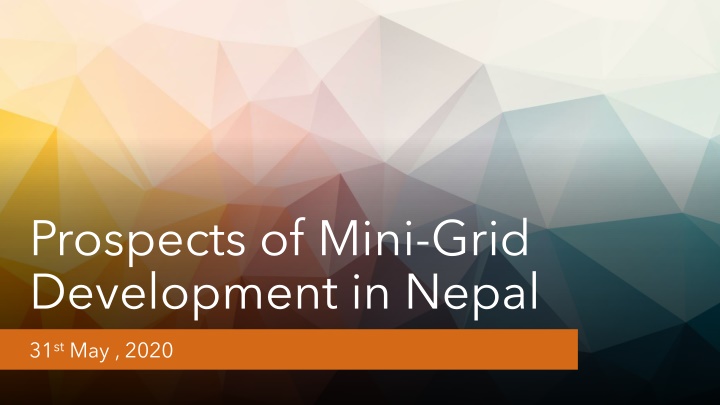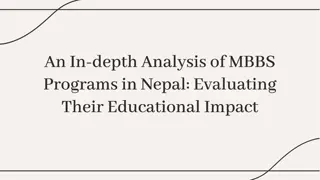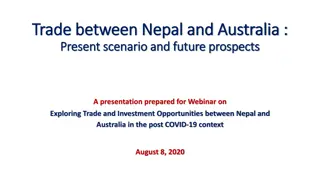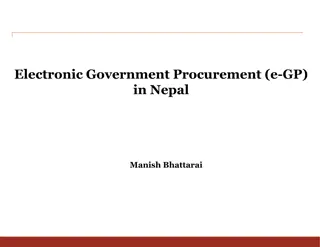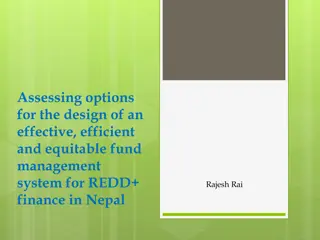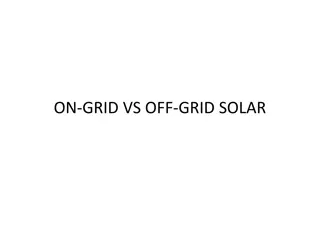Prospects of Mini-Grid Development in Nepal - A Comprehensive Overview
This detailed analysis delves into the current status and future potential of mini-grid development in Nepal, addressing key concerns, data consistency, electrification goals, budget allocations, technological choices, and action plans for advancing the sector.
Download Presentation

Please find below an Image/Link to download the presentation.
The content on the website is provided AS IS for your information and personal use only. It may not be sold, licensed, or shared on other websites without obtaining consent from the author.If you encounter any issues during the download, it is possible that the publisher has removed the file from their server.
You are allowed to download the files provided on this website for personal or commercial use, subject to the condition that they are used lawfully. All files are the property of their respective owners.
The content on the website is provided AS IS for your information and personal use only. It may not be sold, licensed, or shared on other websites without obtaining consent from the author.
E N D
Presentation Transcript
Prospects of Mini-Grid Development in Nepal 31stMay , 2020
Present Future Issues/Concerns Silver lining Action, way forward 2
Electricity access MMHP 764 kW Solar/wind 50 kW SHS 9858 (By Falgun 2076) RE 10% Province Electrifie d % Un- electrifie d (NP) 0 0 0 0 0 3 6 Un- electrifie d (GP) 24 0 8 6 7 38 25 1 2 Bagmati Gandaki 5 Karnali Sudur Pakchhim Total 86.3 87.25 95.83 87.48 89.67 27.74 67.33 Total 68MW Drinking water 90% Irrigation 56% (year round only of 33%) 90.00 9 108 Source: MoF (2077), Economic Survey Source: NEA (2076) quoted in MoF (2077), Economic Survey 3
Concern/Issues Data consistency (Is 100% electrified?) Karnali (<30%) and Sudurpakchhim (<70%) Irrigation may be the game changer! 4
Future 100 % electrification at the end of 15th Five Year Period (2076/77 2080/81) Issue/concern 95% grid and 5% off-grid 5% can translate to around 300,000 households 500 to 600 systems (if one system serves 300 to 500 households) maximum number of mini-grid Source: NPC, 15th Five Year Plan Lift and solar irrigation Budget Rs. 1 Arab 31 Kror RE access (Ujyalo Nepal)- all households in 2 years Budget Rs. 4 Arab 200 solar mini-grid in 97 local level in mountains and hills Budget Rs. 4 Arab 31 kror including other alternate energies Source: Budget Speech (2077) 5
AEPC by now (FY 2018/19) Source: AEPC latest annual report Mini/Micro hydro 32 MW Issue/concern If all these are functional, prospect for future mini-grid development may be insignificantly low .. 68 MW Solar/wind mini-grid 563 kW 5 years is the maximum .. SHS 911,097 6
Silver Lining.. Off-grid (stand-alone) Grid compatible (future possibilities) Grid compatible/connected Mini-grid Hydropower (micro/mini/small) Solar PV Others (wind/biomass) Hybrid Technologies Lighting only Lighting plus (other end usages) Anchor load (irrigation, telecom tower, etc.) Usages Utility model Private Community Mixed Business models 7
Action Way Forward Delineate mini-grid areas (5% not served by NEA) Role: NEA, Ministry, ERC, AEPC Develop Mini-Grid Master Plan(or Plans) - accommodating anchor loads such as irrigation, health, school, etc. Role: AEPC assisting Province and Local Governments (with support from NEA and Ministry) Consideration of technological choices (as determined by usages and economic criteria) Possibility of upgrading existing MMHPs, or new MHPs, solar Adapt Funding Mechanism (which is efficient and promotes cost-effective solutions) Moving away from conventional subsidy regime (some form of financial assistance is required) Adapt a truly business model 8
Game changer Grid connected mini-grids (regulation should be in place) Maximum possible bigger size (going away from the limit .) A complete solution (not only for lighting needs ) SMART technologies (automation, standardization, online) Link to climate funds Local and Provincial government backed by central level AEPC Do not unnecessarily complicate the matter , for example, by inter-connecting ill function small micro-hydro plants into a so-called mini-grid 9
Devendra Adhikari devendra.adhikari@live.com RECON is highly acknowledged for organizing this webinar. Date: June 1, 2020. 10
